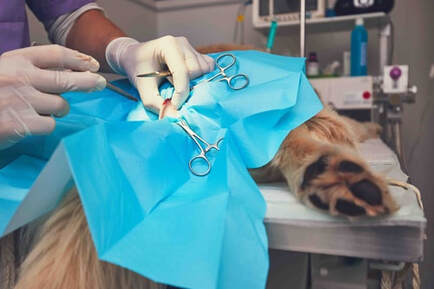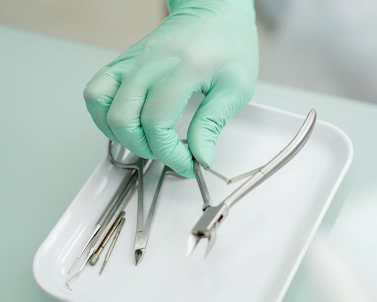 Image by Jaromir Chalabala / Shutterstock.com Image by Jaromir Chalabala / Shutterstock.com Over the past two years, due to the pandemic, a common farewell has been “stay safe”. As we have now farewelled 2021, this would also be an appropriate wish for all working in veterinarian practices. The cleaning method of choice for reusable instruments in most Veterinarian practices is handwashing or ultrasonic cleaners, but is this the best method for the staff or future patients. Due to the Covid-19 pandemic, the general public are now a lot more aware of infections and as many restrictions are now easing, it is an ideal time to consider improvements in your practice’s prevention of healthcare associated infections. There are two audiences to consider. The staff who handle the dirty instruments and the next patient those instruments are used on. With either handwashing or using an ultrasonic cleaner, the staff are handling undisinfected instruments. It is also labour intensive and therefore the opportunity cost is that staff are not available income earning activities. The method that has been used by the medical industry for cleaning dirty instruments used in human procedures for decades, is being adopted in a wider array of practices, including veterinarians. That is the use of a washer disinfector. Here are five benefits why you should consider using a washer disinfector to clean the reusable instruments in your practice. 1. Safety There are three risks that a washer disinfector reduces. There is no need for manual handling prior to using a thermal washer disinfector and only handling of an undisinfected instrument is putting the dirty utensil into the rack of the washer disinfector. Once you run the thermal washer disinfector, the instrument is clean, disinfected and already dry, ready for bagging to be sterilised. Less handling reduces the risk of an injury and exposure to the bacteria and virus present on the instrument. The risk of not properly cleaning the instruments thoroughly of the bio burden and therefore potentially baking on micro organisms via the sterilisation process that can dislodge when used on a future patient. During a cleaning cycle, instruments are repeatedly exposed to high pressure sprays from water jets with a high instrument grade liquid detergent that rapidly breaks down proteins and liquids. Further rinsing cycles removes acid and all traces of detergents. 2. Opportunity Cost Compare the monthly labour costs for the time spent washing dirty instruments by hand and then drying them, to the cost of a washer disinfector that frees up staffs time for revenue generating activities. If they are taking 30 minutes a day to hand wash, it is likely costing your practice more economically than the monthly cost of a machine. Imagine what would be a better use of your staff’s time if the cleaning was automated. In our home lives, we have all moved to using a dishwasher. It’s time to automate the process at work also. The cycle time for a washer disinfector is only 45 - 55 minutes. Once the staff load the machine, they can be doing other tasks. When the cycle is finished the instruments are dry and ready to be bagged for sterilising. 3. Standardisation The operation of a Washer/Disinfector is completely automatic and thus removes the human variabilities from the process. Using a standard process with specified temperatures and a specific time for each part of the cycle, a washer disinfector standardises the results you achieve, consistently every single wash. This consistency provides the practice with a guaranteed level of cleanliness and disinfection that is not possible when manually washing by hand or using an Ultrasonic cleaner. 4. Substantiation There is good scientific evidence that has determined an 80% reduction of <101 micro organisms and 98% with <102, by using a washer disinfector with a final rise of >85C. The evidence also showed that the bacterial contamination on dirty surgical instruments was not reduced by soaking for an hour in detergent. Get the assurance that comes with knowing your instruments are both clean and disinfected before you sterilised them. 5. Self cleaning Regardless how many cycles you use the washer disinfector each day, it self cleans. This eliminates any requirement or time to clean the washer disinfector unit and there is also no downtime while the unit is being cleaned. Sanitech offers two models of Washer Disinfectors that provide all these benefits. There is the larger freestanding unit as well as a bench top unit. As an additional benefit to the local economy, both are proudly made in Australia. For as little as $436.00 per month (over a 36 month period), you could have a Sanitech 9100 Series Thermal Washer Disinfector cleaning all your dirty instruments and providing you all these benefits. To learn more about how your Vet practice can benefit from a Sanitech Washer Disinfector to thermally wash and disinfect your reusable instruments, contact Sanitech on 03 9809 2701 or complete this inquiry form.
0 Comments
 The COVID-19 pandemic has highlighted to people around the globe the importance of infection control, especially when it comes to healthcare procedures. Every patient and staff member of a podiatry clinic has the right to be kept safe from infection, and cleaning reusable instruments has a large role to play in that safety. By using a podiatry instrument thermal washer disinfector you will be conforming to workplace health and safety standards as well as achieving medical-grade standards from a safety perspective. As an employer you will also see improvements in efficiency and free up staff from boring repetitive work, making their job more interesting.
A thermal podiatry washer disinfector like those manufactured by Sanitech, cleans and disinfects re-usable medical instruments and podiatry implements. Workplace Health and Safety benefits Reducing the transmission of microorganisms like bacteria, viruses and fungal infections is paramount for the safe treatment of podiatry patients. Every podiatry practice should have stringent procedures in place to wash and sterilise reusable equipment, and it should comply with the Standard AS/NZS4187. The aim of cleaning is to remove microbial, organic and inorganic soil. All re-usable medical and podiatry instruments should be decontaminated every time they are used on a new patient. Decontamination refers to the combination of cleaning, disinfection, and sterilisation to make a re-usable item safe. Medical grade standards The Australian Guidelines for the Prevention and Control of Infection in Healthcare 2019 published by the National Health and Medical Research Council (NHMRC) state that “Effective infection prevention and control is central to providing high-quality health care for patients and a safe working environment for those that work in healthcare settings”. The Podiatry Board of Australia which governs podiatry practices in this country has adopted these guidelines to keep patients and workers safe. The Australian Standard (AS/NZS 4187-2014) for the washing and disinfection of your surgical instruments and utensils is in place to ensure that health care services correctly clean and disinfect their reusable medical devices (RMD) before and between patient uses to produce RMDs that can be used safely without the risk of transmission of infectious agents. It is recommended that all reusable surgical instruments be washed in an automated washer/disinfector like the Sanitech Bench Top Washer Disinfector. Improved efficiency and making jobs more interesting The role of podiatry assistant can involve a large range of tasks depending on the size of the practice and the skill level of the person. Administrative duties can include ordering, organising and storing supplies, restocking exam rooms, setting up instruments and sterilising equipment. An assistant can also be responsible for greeting patients, scheduling appointments, updating patient files and more. Many podiatry assistants also have clinical duties and can be called up to take a patient’s vital signs, obtain the patient’s medical history, perform physical exams, and discuss treatment procedures with the patient. Some may also need to take X-rays of patients’ legs, ankles and/or feet, prepare patients for procedures, cast for orthotics, assist with foot exams and perform other tasks as needed. Therefore, anything that can make their job more efficient and less tedious is going to be welcome. But it’s not just about happy staff, greater levels of efficiency will also lead to higher profits, and lower staff turnover. By cutting down on manual cleaning work and using professional equipment like the Sanitech Bench Top Washer Disinfector, everyone will benefit, including the patients. Why Sanitech? Sanitech Australia has been at the forefront of infection control for over 35 years. We understand practical infection control and as a result, that knowledge has progressively refined every Sanitech product. In addition, our machines comply with all relevant Australian standards and are manufactured in Australia. Sanitech works closely with podiatrists all around Australia and introduced the popular Clipper Rack as a result of identifying a need in the market. As an Australian manufacturer with over 35-years of experience in the design and fabrication of cleaning and maintenance of surgical instruments, medical instruments, medical equipment, surgical tools, surgical instrument racks, podiatry instruments and podiatry surgical instruments, Sanitech is leading the market. Learn more about Sanitech’s range of cleaning equipment for Podiatrists here or call us on (03) 9809 2701. |
AuthorGraham Scott has been the managing director of Sanitech Australia for over 24 years. He has extensive experience in the industry and has always strived for best practice. Archives
December 2021
Categories |
Quick Links: |
Sanitech |
|

 RSS Feed
RSS Feed
